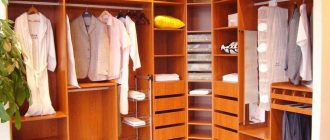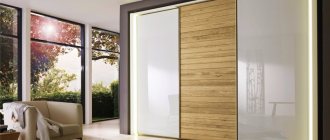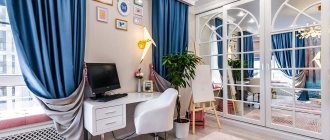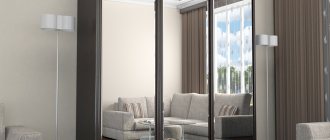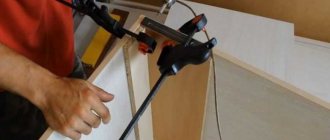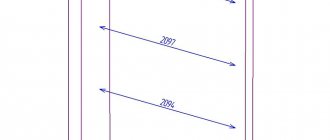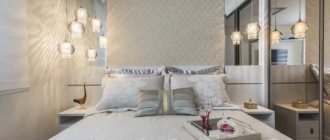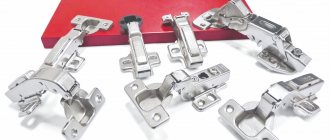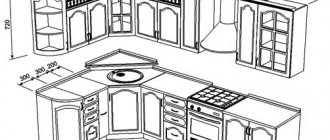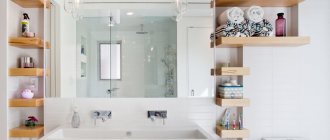There are a large number of models and options for how to plan and arrange the filling of a wardrobe. When deciding on a particular model of filling for a dressing room, you need to take into account many nuances. These include the individual wishes of the person, the type of room in which the wardrobe will be located, and the shape of the furniture.
The internal content of the wardrobe should be functional and practical. Therefore, it is necessary to make maximum use of all the space so that there are no free niches or space between the shelves. Things should be arranged so that they “breathe”, do not interfere with each other, and are always in a visible place.
Wardrobe filling
There are many options for designing the interior space of sliding wardrobes, for which various elements and designs are used. They can not only be built inside the dressing room, but rearranged, making redevelopment from time to time. The basic kits for creating the “filling” of a cabinet usually include the following elements:
- Drawers, which can be of different shapes, have dividers. Typically, such designs are used for laying out socks and underwear.
- Shelves designed for wrinkle-resistant clothing items.
- Area of hangers on which wrinkled clothes are placed. They are mesh, retractable and stationary. Built-in and stationary are suitable for placing winter things, including sweaters, books, shoes. It is customary to place light clothing items on pull-out shelves - T-shirts, shorts, shirts, jeans, accessories.
- Crossbars for trousers, jeans, skirts, dresses.
- Shelves - mesh or regular, designed for shoes.
- Shelves and areas with hooks for bags and ties.
- Spacious shelves and mezzanines on which beds and blankets are placed.
- Crossbars for hangers designed to accommodate outerwear.
An ideal closet is the presence of all of the above structures, preferably modular and built-in. As a result, you can rebuild your dressing room, taking into account the changing seasons and the weather patterns in each of them.
Thus, the interior space of the dressing room is divided into three parts - upper, lower, main. The first is intended for mezzanines or shelves where hats and suitcases are placed. The second one, the bottom one, is suitable for storing accessories, shoes and documents. The main part is installing hangers and shelves.
Design and colors
Modern manufacturers and workshops working with custom-made furniture offer a wide variety of sliding wardrobes. The following materials are used for the production of facades:
- mirrors;
- artificial leather (or its substitute);
- laminated chipboard;
- MDF;
- plastic;
- rattan;
- bamboo;
- tree;
- glass;
- lakomat - frosted translucent glass;
- lacobel - painted glass;
- decoacrylic;
- glass with Oracal film.
After solving practical issues related to the design of the cabinet and the place for its installation, then when choosing, they focus on the style of the room.
Mirrors
Eco leather
laminated chipboard
MDF
Plastic
Rattan
Bamboo
Tree
Lakomat
Lakobel
Oracal film
Panels can be complemented with various decorative elements:
- sandblasting pattern;
- half-timbered lattice;
- photo printing;
- painting;
- film stained glass;
- fusing (decoration made of multi-colored glass, which is sintered at high temperature);
- spraying;
- laser engraving;
- mosaic elements;
- veneer;
- images created using airbrushing.
Tips for choosing a three-door wardrobe, placement features
Due to the variable design possibilities, such furniture is used in interiors of a wide variety of styles. The most common are models made in modern design styles. Less commonly produced are cabinets with sliding doors in classic, Italian, as well as such styles as baroque, art deco, empire, retro, Provence, and country.
Sandblasting drawing
Photo printing
painting
Stained glass
Fusing
Engraving
Mosaic
The palette for facades includes many colors and their shades. A specific tone is chosen taking into account a number of nuances. You definitely need to make sure that the color compatibility of the cabinet, other interior items (including furniture and decorative elements) and walls. It is also important to take into account the style of the room and personal perception.
Tips from designers on how to combine colors in the interior:
- Use a mono palette. One color is taken as a basis. The interior will have 3 options: basic, light and dark. You can determine the required tone using a color wheel, in which similar colors are adjacent, and contrasting ones are at opposite ends.
- Choose contrasting shades. It is important not to overdo it, otherwise you can create color dissonance, which will only cause irritation.
- Use 2 colors close in color palette + add one contrasting one to them.
Designers do not recommend tying the color of furniture to the shade of the floor and entrance doors.
Monopalette
Contrasting shades
Shades similar in color palette
Popular options are cabinets:
- with a mirror facade, which creates a visual effect of expanding the space;
- with glass transparent (translucent) sliding panels;
- with a plastic glossy or matte surface.
Review of the main models of sliding wardrobes, tips on selection and placement
Options that include a transparent door are rare. Facades that sharply contrast with the color of the walls, as well as those that completely match it or are close in shade are considered relevant. Designs intended for living rooms and bedrooms are often complemented by a compartment for a TV. Some are equipped with open shelves for small things and comfortable cabinets. They are also equipped with compartments for outerwear with hooks and space for hats.
Mirror facade
Glass sliding panels
Plastic surface
Filling the built-in wardrobe in the bedroom
A closet is perfect for storing things and shoes, inside of which there will be many shelves and a rod for placing hangers with shirts, trousers and dresses. It is better that the designed space is closed. This applies to both the entire cabinet and internal modules.
For small rooms in which small dressing rooms measuring 2 by 2 meters or 2 by 3 meters are made, it is recommended to close the wardrobes with sliding doors. This saves a lot of space in the bedroom.
When planning the internal filling of a wardrobe that will be in the bedroom, you need to consider the following points:
- The dressing room should be deep enough and roomy, which will allow you to place bed linen, home and casual clothes, and shoes.
- The ideal depth for a wardrobe in a bedroom is 50-60 cm, which is needed to install a standard size rod and pull out drawers.
- In the interior arrangement it is necessary to use various modular sections designed for shoes and accessories.
Filling the wardrobe in the bedroom involves the use of components such as:
- Shelves and niches necessary for storing shoes.
- Mounting for an ironing board and iron, if the interior space of the dressing room allows.
- A pantograph rod equipped with a trigger and handle necessary for height adjustment. Layout of the wardrobe using a pantograph, which is a special design attached to the side or rear walls of the shelves. If the need arises, such a mechanism can be easily pulled out.
- Hangers for hangers.
- Hangers with hooks are necessary for placing things that will not wrinkle.
- Trouser holders.
- Pull-out baskets that will be pulled out and placed at different levels. They are great for storing belts, ties, socks, and small accessories.
Types of components
The quality of components for sliding wardrobes must be high. Each part performs its functions and is selected in accordance with the content and dimensions of this type of furniture. Homemade elements will lead to a reduction in the service life of products.
Sliding systems
Parts of sliding systems can be purchased separately, and sets are also available. They can be supported or suspended. The first version of sliding systems includes rollers with two guides and a profile for the frame. It is easy to install and has a high level of reliability. This type of sliding system is used if the doors are heavy. Hanging fittings consist of an upper guide, rollers, and stoppers. The profile is fixed on the top cover of the housing or attached directly to the ceiling.
Types of fittings for sliding wardrobes, functionality of elements
The wardrobe includes connecting elements and plugs. As for the materials for making profiles for door panels, it can be aluminum, plastic, steel. Each material has its own characteristics.
| Material | Characteristic |
| Aluminum | Mainly used for making rail supports. Such components are used most often, as they are practical, reliable and characterized by a long service life. |
| Plastic | This profile has a low cost, but its strength is not too high. It can be combined with a metal edging, which enhances the technical characteristics |
| Steel | Such door frames are characterized by high strength and durability. The cost of the material depends on the reputation of the manufacturer and may be deliberately inflated |
Aluminum profiles for door leaves are used even in large-sized structures. When choosing any component, you should not resort to the cheapest option, otherwise the cabinet will quickly stop functioning.
Aluminum
Plastic
Steel
Rollers
Rollers are a structural element that ensures the movement of wardrobe doors. They do not allow the canvas to slide along the guide without permission, and also facilitate the process of opening and closing. The movements are smooth and almost silent. Roller rims are made of plastic, rubber, Teflon or steel.
When used correctly, these elements can last for many years, since they are designed in such a way that dust does not get inside the mechanism. One way or another, in the event of a breakdown, installing new rollers for the wardrobe with your own hands will not be difficult at all. Thanks to this component, it is possible to adjust the position and height of the door leaves. The number of wheels is determined by the weight of the doors.
Rollers can be asymmetrical or symmetrical. The first option is used to move the door leaf along the lower guide profile. The second is characterized by fastening wheels on the lower and upper sides. It is intended for glass, mirror or plastic panels.
Asymmetrical
Symmetrical
Sealant
The seal is necessary to hide the gaps between the door leaf and the frame. It is attached to the side of the doors, ensuring a tight fit to the body. There are several types of products:
- Universal. Used when installing heavy doors.
- Silicone. This seal is not hazardous to health and ensures reliable fixation of the sashes in the profile frame.
- Brush. It consists of pile attached to adhesive tape.
Variety of models of two-door wardrobes, examples of placement
The width of the seal depends on the type of canvas and varies between 4–8 mm. The element comes with or without a self-adhesive base.
Universal
Silicone
Brush
Stopper and separator
The separator is more often used in designer models. It is made of glass, chipboard. The thickness of this fragment varies. A stopper is a component that secures the wardrobe door leaf in the right place, usually made of steel. The product has the shape of antennae and has high springy properties. The part must be installed in the lower guide profile.
Stopper
Delimiter
Retractable structures
The internal content of the wardrobe depends on how functional the furniture should be. Most often it is represented by retractable elements, for the use of which the following guides are installed:
- Roller. This type is the most common, but has a serious drawback - the elements are pulled out partially or completely. The maximum permissible load is 25 kg.
- Ball. There are small balls inside the profile, which ensure easy sliding of shelves or drawers.
- Tandems. The guides in this case are hidden inside the drawer. This system allows you to effectively use the entire internal space of the cabinet. It is expensive, but operates smoothly and silently.
- Metaboxes. In addition to guides, they include sidewalls made of plastic or metal. There are options that are put forward partially or completely. The height of the walls and the depth of the box may vary.
What accessories will be used depends on the financial capabilities of the people. Among the wide variety of elements, you can always find exactly what is suitable for a specific product model.
Roller
Ball
Tandem
Metabox
Additional items
It will be useful to supplement the furniture set with some practical details. A mezzanine for storing things that do not require constant access would not be superfluous. In addition, the cabinet may contain the following additional components:
- Shelves. There are retractable or fixed ones. The distance between them is about 30 cm. The first type is more convenient to use, but costs more.
- Drawers. A popular option is the full extension system, which provides easy access to everything. The height of the drawers is usually 20–30 cm. They are intended for laying out clothes that do not wrinkle.
- Barbells. They are used to store things on hangers or hangers.
- Pantograph. This is a device that extends the bar with clothes to a convenient level at a large height of the structure. The product can be mechanical or electrical.
- Shoe racks. They are mobile and mounted at the bottom of the wardrobe at a certain angle.
- Baskets. Most often they are retractable.
An additional element can be considered a crossbar to which hangers cling. It can also be fixed or retractable. In addition, the closet has a structure for storing ties, belts, and small items.
Shelves
Drawers
Barbell
Pantograph
Shoe rack
Baskets
Filling wardrobes in the hallway
For wardrobes that are installed in hallways or corridors, you need to develop individual layouts for placing things. This will help you plan the placement of components, taking into account the size of the cabinet, its shape and location.
Shoes can be placed on shelves made of wire and installed at a slight angle. The internal layout of the closet requires the use of drawers, in which you can put brushes and shoe polish, keys, and place slippers. The main part of the space is allocated for outerwear.
There are also options for placing things inside a wardrobe, such as sectional ones. They allow you to arrange hangers, hat holders, seats and corner shelves in dressing rooms, arranging them the way the apartment resident wants.
Placing things in cabinets on loggias
A wardrobe installed on the balcony, inside of which it is as convenient to place things as in the hallway, is spacious and practical. All elements must meet the functional purpose of the dressing room. So, if the closet is made to store winter things, then you need rods, shelves - stationary and inclined, and hooks. Sloping shelves can hold shoes, hooks can hold gloves, scarves and other accessories, and regular shelves can hold boxes of shoes, winter sweaters and jeans.
A sliding wardrobe on a balcony is usually built-in, and comes in two types - straight or corner, which affects the internal content of such a dressing room.
Features of filling a closet in a nursery
Sliding wardrobes for children are designed for storing things, shoes, books and toys, notebooks, paints. You can also place a computer desk inside to optimize the space in the room. Most often, three-door wardrobes are installed in children's rooms, which are distinguished by their large capacity due to the presence of an additional section. Among the features of the filling for sliding wardrobes in the nursery, it is worth noting the following:
- Shelves and drawers that allow you to place textbooks, notebooks and stationery.
- Corner open modules with shelves on which books and toys are placed.
- Mesh sections for placing sports equipment.
The doors in such cabinets should open easily, and the shelves should be secured using special flippers.
Thus, the internal filling of sliding wardrobes can be very different, but it always contains shelves, drawers and hangers. The presence of additional elements only hooks, upper mezzanines and pull-out shelves helps to increase the functionality of the dressing room, expand the usable space, and place not only clothes and shoes, but also socks, ties and bags.
Tips for choosing
You need to select components for sliding wardrobes based on the quality of the parts. The rigidity of metal products, as well as the smoothness and softness of the roller systems, determine the durability and ease of use of a piece of furniture. Door hardware must withstand daily loads, so you should not purchase cheap models. It is important that the internal content is properly planned. It is necessary to pay attention to the material of manufacture of all components. You should also consider the following recommendations:
- the size of the guides must correspond to the dimensions of the cabinet and the length of the doors;
- the rollers must ensure smooth and silent running;
- closers need to be chosen that will easily withstand the weight of the door leaf;
- sealants should not shrink or leave marks on the surface.
When choosing the main components, you need to pay attention not only to the quality of the material, but also to the reputation of the manufacturer. The design will last a long time if the components are selected in accordance with the dimensions of the product. You also need to know the rules for operating sliding wardrobes.
A sliding wardrobe is a universal piece of furniture in which you can store a huge number of things. It fits well into any interior and also helps to divide the space into zones. The correct choice of model will allow you to implement even the most complex project.
How to fit a classic-style wardrobe into the interior, tips
The size of the guides must correspond to the dimensions of the facade
It is better to choose silent rollers
Closers must be able to withstand the weight of the door leaf
It is important that the seal does not shrink
